Kushano-Sasanian Kingdom
Kushano-Sasanian Kingdom (also called Kushanshas KΟÞANΟ ÞAΟ Koshano Shao in Bactrian,[4] or Indo-Sassanians) is a historiographic term used by modern scholars[5] to refer to a branch of the Sasanian Persians who established their rule in Bactria and in northwestern Indian subcontinent (present day Pakistan) during the 3rd and 4th centuries at the expense of the declining Kushans. They captured the provinces of Sogdiana, Bactria and Gandhara from the Kushans in 225 AD.[6] The Sasanians established governors for the Sasanian Empire, who minted their own coinage and took the title of Kushanshas, i.e. "Kings of the Kushans".[6] They are sometimes considered as forming a "sub-kingdom" inside the Sasanian Empire.[7] This administration continued until 360-370 AD,[6] when the Kushano-Sasanians lost much of its domains to the invading Kidarite Huns, whilst the rest was incorporated into the imperial Sasanian Empire.[8] Later, the Kidarites were in turn displaced by the Hephthalites.[9] The Sasanians were able to re-establish some authority after they destroyed the Hephthalites with the help of the Turks in 565, but their rule collapsed under Arab attacks in the mid 7th century.
Kushano-Sasanian Kingdom Kushanshahr | |||||||||
|---|---|---|---|---|---|---|---|---|---|
| c.230 CE–c.365 CE | |||||||||
 Sasanian Empire (orange), and the Kushano-Sasanian realm (violet), centered on Kushanshahr, the province at the eastern edge of the Sasanian Empire. There are four main areas where Kushano-Sasanian coins were minted (Kabul, Balkh, Herat, and Merv), although it seems Merv and Herat remained Sasanian.[3][2] | |||||||||
| Capital | Balkh | ||||||||
| Common languages | Middle Persian | ||||||||
| Religion | Zoroastrianism | ||||||||
| Government | Feudal monarchy | ||||||||
| Historical era | Late Antiquity | ||||||||
• Established | c.230 CE | ||||||||
• Disestablished | c.365 CE | ||||||||
| |||||||||
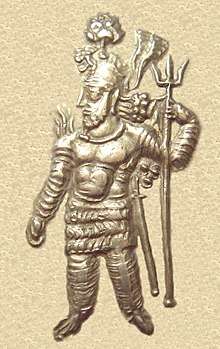
The Kushanshas are mainly known through their coins. Their coins were minted at Kabul, Balkh, Herat, and Merv, attesting the extent of their realm.[2]
A rebellion of Hormizd I Kushanshah (277-286 CE), who issued coins with the title Kushanshahanshah ("King of kings of the Kushans"), seems to have occurred against contemporary emperor Bahram II (276-293 CE) of the Sasanian Empire, but failed.[6]
History
First Kushano-Sassanid period
The Sassanids, shortly after victory over the Parthians, extended their dominion into Bactria during the reign of Ardashir I around 230 CE, then further to the eastern parts of their empire in western Pakistan during the reign of his son Shapur I (240–270). Thus the Kushans lost their western territory (including Bactria and Gandhara) to the rule of Sassanid nobles named Kushanshahs or "Kings of the Kushans". The farthest extent of the Kushano-Sasanians to the east appears to have been Gandhara, and they apparently did not cross the Indus river, since almost none of their coinage has been found in the city of Taxila just beyond the Indus.[10]

The Kushano-Sasanians under Hormizd I Kushanshah seem to have led a rebellion against contemporary emperor Bahram II (276-293 CE) of the Sasanian Empire, but failed.[6] According to the Panegyrici Latini (3rd-4th century CE), there was a rebellion of a certain Ormis (Ormisdas) against his brother Bahram II, and Ormis was supported the people of Saccis (Sakastan).[2] Hormizd I Kushanshah issued coins with the title Kushanshahanshah ("King of kings of the Kushans"),[11] probably in defiance of imperial Sasanian rule.[6]
Around 325, Shapur II was directly in charge of the southern part of the territory, while in the north the Kushanshahs maintained their rule. Important finds of Sasanian coinage beyond the Indus in the city of Taxila only start with the reigns of Shapur II (r.309-379) and Shapur III (r.383-388), suggesting that the expansion of Sasanian control beyond the Indus was the result of the wars of Shapur II "with the Chionites and Kushans" in 350-358 as described by Ammianus Marcellinus.[10] They probably maintained control until the rise of the Kidarites under their ruler Kidara.[10]
The decline of the Kushans and their defeat by the Kushano-Sasanians and the Sasanians, was followed by the rise of the Kidarites and then the Hephthalites (Alchon Huns) who in turn conquered Bactria and Gandhara and went as far as central India. They were later followed by Turk Shahi and then the Hindu Shahi, until the arrival of Muslims to north-western parts of India.
Second Kushano-Sassanid period
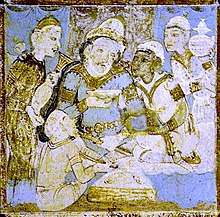
The Hephthalites dominated the area until they were defeated in 565 CE by an alliance between the Gokturks and Sassanids, and some Indo-Sassanid authority was re-established. The Kushano-Hephthalites were able to set up rival states in Kapisa, Bamiyan, and Kabul. The 2nd Indo-Sassanid period ended with the collapse of Sassanids to the Rashidun Caliphate in the mid 7th century. Sind remained independent until the Arab invasions of India in the early 8th century. The Kushano-Hephthalites or Turkshahis were replaced by the Shahi in the mid 8th century.
Religious influences
Coins depicting Shiva and the Nandi bull have been discovered, indicating a strong influence of Shaivite Hinduism.
The prophet Mani (210–276 CE), founder of Manichaeism, followed the Sassanids' expansion to the east, which exposed him to the thriving Buddhist culture of Gandhara. He is said to have visited Bamiyan, where several religious paintings are attributed to him, and is believed to have lived and taught for some time. He is also related to have sailed to the Indus valley area now in modern-day Pakistan in 240 or 241 AD, and to have converted a Buddhist King, the Turan Shah of India.[13]
On that occasion, various Buddhist influences seem to have permeated Manichaeism: "Buddhist influences were significant in the formation of Mani's religious thought. The transmigration of souls became a Manichaean belief, and the quadripartite structure of the Manichaean community, divided between male and female monks (the 'elect') and lay follower (the 'hearers') who supported them, appears to be based on that of the Buddhist sangha"[13]
Artistic influences
The Indo-Sassanids traded goods such as silverware and textiles depicting the Sassanid emperors engaged in hunting or administering justice. The example of Sassanid art was influential on Kushan art, and this influence remained active for several centuries in the northwest South Asia.
Main Kushano-Sassanid rulers
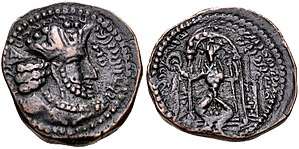
The following Kushanshahs were:[14]
- Ardashir I Kushanshah (230–245)
- Peroz I Kushanshah (245–275)
- Hormizd I Kushanshah (275–300)
- Hormizd II Kushanshah (300–303)
- Peroz II Kushanshah (303–330)
- Varahran Kushanshah (330-365)
Coinage
| Wikimedia Commons has media related to Kushano-Sasanian Kingdom. |
The Kushano-Sassanids created an extensive coinage with legend in Brahmi, Pahlavi or Bactrian, sometimes inspired from Kushan coinage, and sometimes more clearly Sassanid.
The obverse of the coin usually depicts the ruler with elaborate headdress and on the reverse either a Zoroastrian fire altar, or Shiva with the bull Nandi.
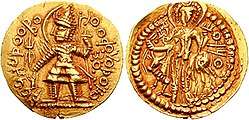
 Indo-Sassanid coin.
Indo-Sassanid coin.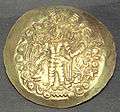 A gold Indo-Sassanid coin.
A gold Indo-Sassanid coin.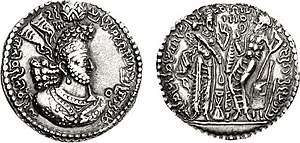
 Peroz III Kushanshah
Peroz III Kushanshah
See also
| Outline of South Asian history | ||||||||||||||||||||||||||||||||||||||||||||||||||||||||||||||||||||||||||||||||||||||||||||||||||
|---|---|---|---|---|---|---|---|---|---|---|---|---|---|---|---|---|---|---|---|---|---|---|---|---|---|---|---|---|---|---|---|---|---|---|---|---|---|---|---|---|---|---|---|---|---|---|---|---|---|---|---|---|---|---|---|---|---|---|---|---|---|---|---|---|---|---|---|---|---|---|---|---|---|---|---|---|---|---|---|---|---|---|---|---|---|---|---|---|---|---|---|---|---|---|---|---|---|---|
_without_national_boundaries.svg.png) | ||||||||||||||||||||||||||||||||||||||||||||||||||||||||||||||||||||||||||||||||||||||||||||||||||
|
Palaeolithic (2,500,000–250,000 BC) |
||||||||||||||||||||||||||||||||||||||||||||||||||||||||||||||||||||||||||||||||||||||||||||||||||
|
Neolithic (10,800–3300 BC)
|
||||||||||||||||||||||||||||||||||||||||||||||||||||||||||||||||||||||||||||||||||||||||||||||||||
|
Chalcolithic (3500–1500 BC)
|
||||||||||||||||||||||||||||||||||||||||||||||||||||||||||||||||||||||||||||||||||||||||||||||||||
|
Bronze Age (3300–1300 BC)
|
||||||||||||||||||||||||||||||||||||||||||||||||||||||||||||||||||||||||||||||||||||||||||||||||||
|
Iron Age (1500–200 BC)
|
||||||||||||||||||||||||||||||||||||||||||||||||||||||||||||||||||||||||||||||||||||||||||||||||||
|
Middle Kingdoms (230 BC – AD 1206)
|
||||||||||||||||||||||||||||||||||||||||||||||||||||||||||||||||||||||||||||||||||||||||||||||||||
|
Late medieval period (1206–1526)
|
||||||||||||||||||||||||||||||||||||||||||||||||||||||||||||||||||||||||||||||||||||||||||||||||||
|
Early modern period (1526–1858)
|
||||||||||||||||||||||||||||||||||||||||||||||||||||||||||||||||||||||||||||||||||||||||||||||||||
|
Colonial states (1510–1961)
|
||||||||||||||||||||||||||||||||||||||||||||||||||||||||||||||||||||||||||||||||||||||||||||||||||
|
Periods of Sri Lanka
|
||||||||||||||||||||||||||||||||||||||||||||||||||||||||||||||||||||||||||||||||||||||||||||||||||
|
Specialised histories |
||||||||||||||||||||||||||||||||||||||||||||||||||||||||||||||||||||||||||||||||||||||||||||||||||
References
- ALRAM, MICHAEL (2014). "From the Sasanians to the Huns New Numismatic Evidence from the Hindu Kush". The Numismatic Chronicle (1966-). 174: 266. ISSN 0078-2696. JSTOR 44710198.
- Encyclopedia Iranica
- ALRAM, MICHAEL (2014). "From the Sasanians to the Huns New Numismatic Evidence from the Hindu Kush". The Numismatic Chronicle (1966-). 174: 266. ISSN 0078-2696. JSTOR 44710198.
- Rezakhani, Khodadad. From the Kushans to the Western Turks. p. 204.
- Rezakhani 2017, p. 72.
- The Cambridge History of Iran, Volume 3, E. Yarshater p.209 ff
- The Cambridge Companion to the Age of Attila, Michael Maas, Cambridge University Press, 2014 p.284 ff
- Rezakhani 2017, p. 83.
- Sasanian Seals and Sealings, Rika Gyselen, Peeters Publishers, 2007, p.1
- Ghosh, Amalananda (1965). Taxila. CUP Archive. pp. 790–791.
- CNG Coins
- The Buddhist Caves at Aurangabad: Transformations in Art and Religion, Pia Brancaccio, BRILL, 2010 p.82
- Richard Foltz, Religions of the Silk Road, New York: Palgrave Macmillan, 2010
- Rezakhani 2017, p. 78.
- CNG Coins
Sources
- Cribb, Joe (2018). Rienjang, Wannaporn; Stewart, Peter (eds.). Problems of Chronology in Gandhāran Art: Proceedings of the First International Workshop of the Gandhāra Connections Project, University of Oxford, 23rd-24th March, 2017. University of Oxford The Classical Art Research Centre Archaeopress. ISBN 978-1-78491-855-2.CS1 maint: ref=harv (link)

- Cribb, Joe (2010). Alram, M. (ed.). "The Kidarites, the numismatic evidence.pdf". Coins, Art and Chronology Ii, Edited by M. Alram et al. Coins, Art and Chronology II: 91–146.CS1 maint: ref=harv (link)

- Daryaee, Touraj; Rezakhani, Khodadad (2017). "The Sasanian Empire". In Daryaee, Touraj (ed.). King of the Seven Climes: A History of the Ancient Iranian World (3000 BCE - 651 CE). UCI Jordan Center for Persian Studies. pp. 1–236. ISBN 978-0-692-86440-1.CS1 maint: ref=harv (link)
- Payne, Richard (2016). "The Making of Turan: The Fall and Transformation of the Iranian East in Late Antiquity". Journal of Late Antiquity. Baltimore: Johns Hopkins University Press. 9: 4–41. doi:10.1353/jla.2016.0011.CS1 maint: ref=harv (link)

- Rapp, Stephen H. (2014). The Sasanian World through Georgian Eyes: Caucasia and the Iranian Commonwealth in Late Antique Georgian Literature. London: Ashgate Publishing, Ltd. ISBN 978-1-4724-2552-2.CS1 maint: ref=harv (link)
- Rezakhani, Khodadad (2017). "East Iran in Late Antiquity". ReOrienting the Sasanians: East Iran in Late Antiquity. Edinburgh University Press. pp. 1–256. ISBN 978-1-4744-0030-5. JSTOR 10.3366/j.ctt1g04zr8.CS1 maint: ref=harv (link) (registration required)
- Rypka, Jan; Jahn, Karl (1968). History of Iranian literature. D. Reidel.CS1 maint: ref=harv (link)
- Sastri, Nilakanta (1957). A Comprehensive History of India: The Mauryas & Satavahanas. Orient Longmans. p. 246.CS1 maint: ref=harv (link)
- Vaissière, Étienne de La (2016). "Kushanshahs i. History". Encyclopaedia Iranica.CS1 maint: ref=harv (link)
- Wiesehöfer, Joseph (1986). "Ardašīr I i. History". Encyclopaedia Iranica, Vol. II, Fasc. 4. pp. 371–376.CS1 maint: ref=harv (link)
External links
| Timeline and cultural period |
Northwestern India (Punjab-Sapta Sindhu) |
Indo-Gangetic Plain | Central India | Southern India | ||
| Upper Gangetic Plain (Ganga-Yamuna doab) |
Middle Gangetic Plain | Lower Gangetic Plain | ||||
| IRON AGE | ||||||
| Culture | Late Vedic Period | Late Vedic Period (Srauta culture)[lower-alpha 1] Painted Grey Ware culture |
Late Vedic Period (Shramanic culture)[lower-alpha 2] Northern Black Polished Ware |
Pre-history | ||
| 6th century BC | Gandhara | Kuru-Panchala | Magadha | Adivasi (tribes) | ||
| Culture | Persian-Greek influences | "Second Urbanisation" Rise of Shramana movements Jainism - Buddhism - Ājīvika - Yoga |
Pre-history | |||
| 5th century BC | (Persian conquests) | Shaishunaga dynasty | Adivasi (tribes) | |||
| 4th century BC | (Greek conquests) | Nanda empire | ||||
| HISTORICAL AGE | ||||||
| Culture | Spread of Buddhism | Pre-history | Sangam period (300 BC – 200 AD) | |||
| 3rd century BC | Maurya Empire | Early Cholas Early Pandyan Kingdom Satavahana dynasty Cheras 46 other small kingdoms in Ancient Thamizhagam | ||||
| Culture | Preclassical Hinduism[lower-alpha 3] - "Hindu Synthesis"[lower-alpha 4] (ca. 200 BC - 300 AD)[lower-alpha 5][lower-alpha 6] Epics - Puranas - Ramayana - Mahabharata - Bhagavad Gita - Brahma Sutras - Smarta Tradition Mahayana Buddhism |
Sangam period (continued) (300 BC – 200 AD) | ||||
| 2nd century BC | Indo-Greek Kingdom | Shunga Empire Maha-Meghavahana Dynasty |
Early Cholas Early Pandyan Kingdom Satavahana dynasty Cheras 46 other small kingdoms in Ancient Thamizhagam | |||
| 1st century BC | ||||||
| 1st century AD | Kuninda Kingdom | |||||
| 2nd century | Kushan Empire | |||||
| 3rd century | Kushano-Sasanian Kingdom | Kushan Empire | Western Satraps | Kamarupa kingdom | Kalabhra dynasty Pandyan Kingdom (Under Kalabhras) | |
| Culture | "Golden Age of Hinduism"(ca. AD 320-650)[lower-alpha 7] Puranas Co-existence of Hinduism and Buddhism | |||||
| 4th century | Kidarites | Gupta Empire Varman dynasty |
Kalabhra dynasty Pandyan Kingdom (Under Kalabhras) Kadamba Dynasty Western Ganga Dynasty | |||
| 5th century | Hephthalite Empire | Alchon Huns | Kalabhra dynasty Pandyan Kingdom (Under Kalabhras) Vishnukundina | |||
| 6th century | Nezak Huns Kabul Shahi |
Maitraka | Adivasi (tribes) | Badami Chalukyas Kalabhra dynasty Pandyan Kingdom (Under Kalabhras) | ||
| Culture | Late-Classical Hinduism (ca. AD 650-1100)[lower-alpha 8] Advaita Vedanta - Tantra Decline of Buddhism in India | |||||
| 7th century | Indo-Sassanids | Vakataka dynasty Empire of Harsha |
Mlechchha dynasty | Adivasi (tribes) | Pandyan Kingdom (Under Kalabhras) Pandyan Kingdom(Revival) Pallava | |
| 8th century | Kabul Shahi | Pala Empire | Pandyan Kingdom Kalachuri | |||
| 9th century | Gurjara-Pratihara | Rashtrakuta dynasty Pandyan Kingdom Medieval Cholas Pandyan Kingdom (Under Cholas) Chera Perumals of Makkotai | ||||
| 10th century | Ghaznavids | Pala dynasty Kamboja-Pala dynasty |
Kalyani Chalukyas Medieval Cholas Pandyan Kingdom (Under Cholas) Chera Perumals of Makkotai Rashtrakuta | |||
References and sources for table References
Sources
| ||||||


